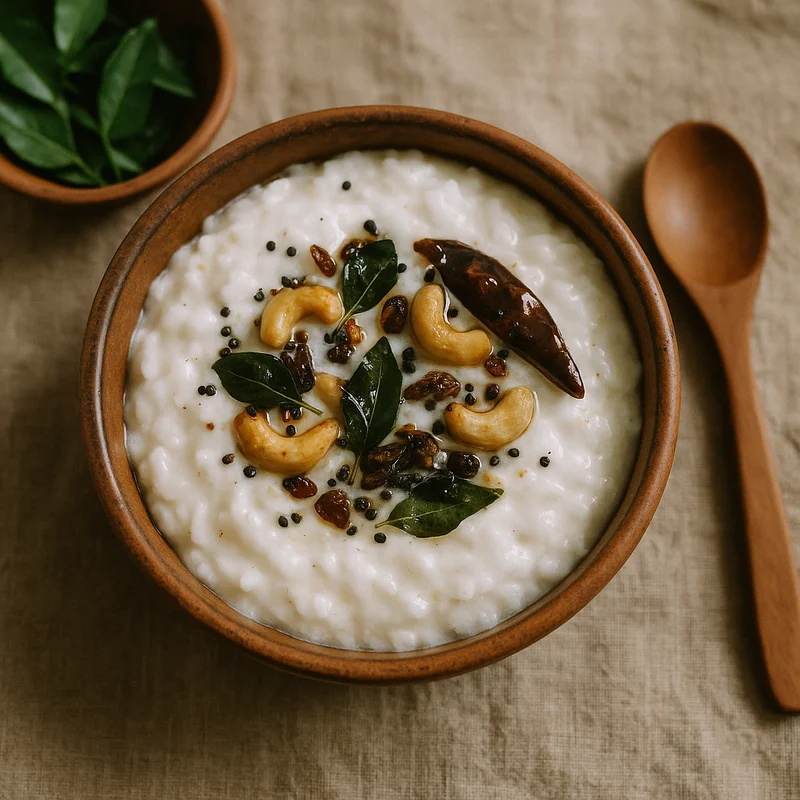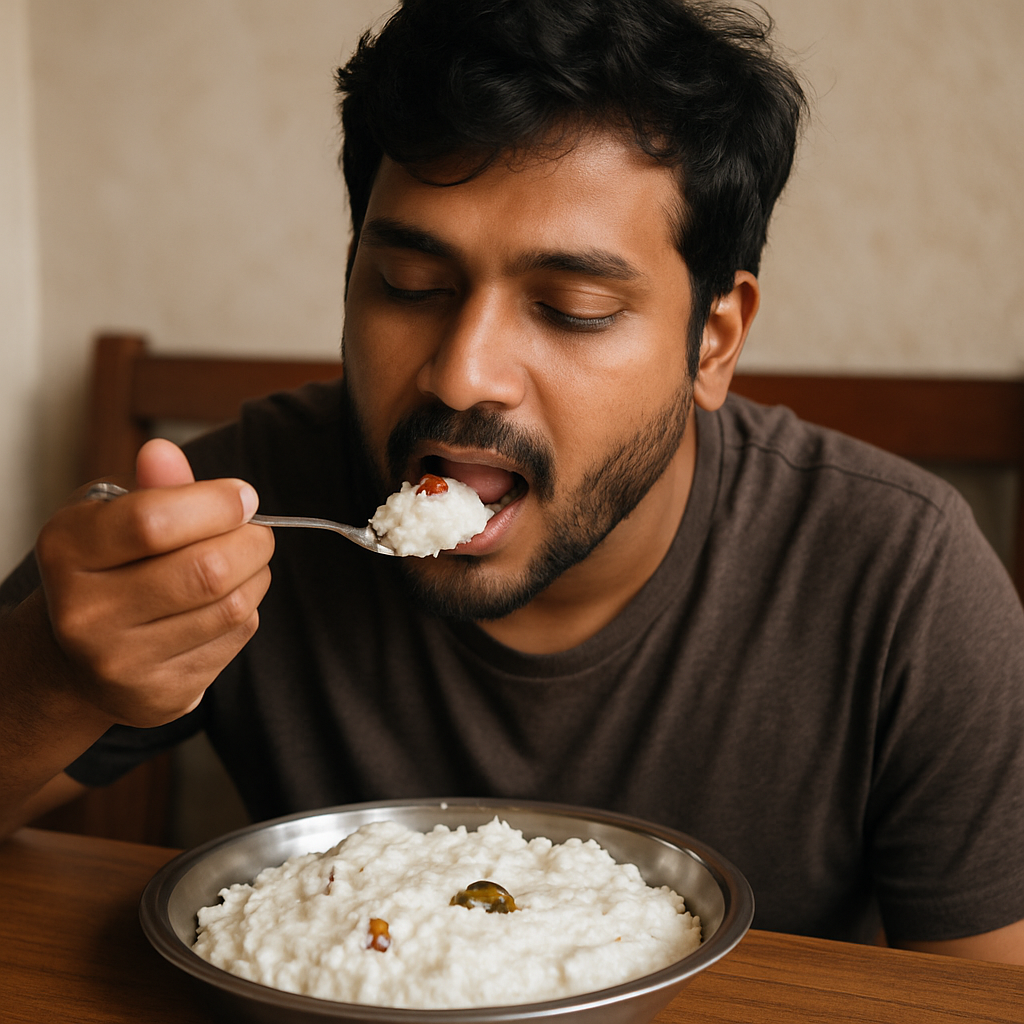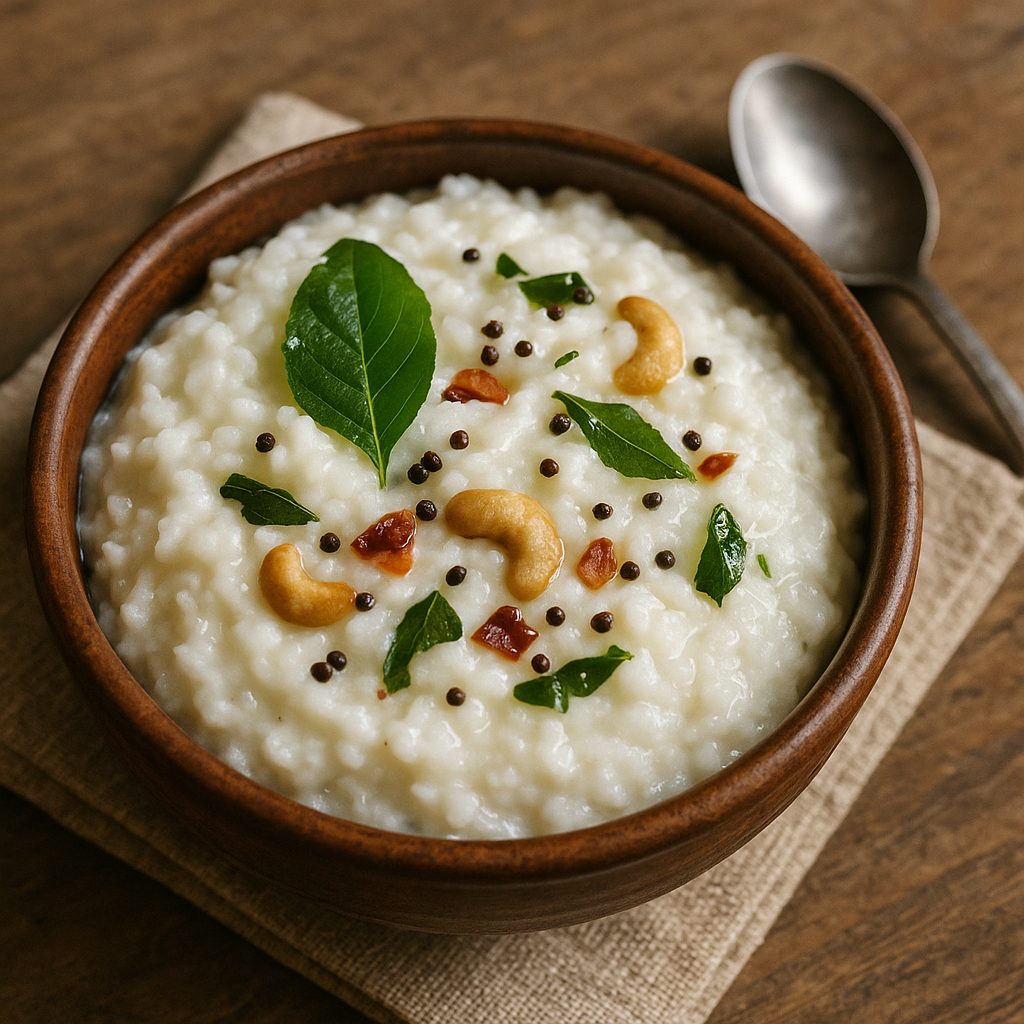Ask Ayurvedic doctor a question and get a consultation online on the problem of your concern in a free or paid mode. More than 2,000 experienced doctors work and wait for your questions on our site and help users to solve their health problems every day.
Shop Now in Our Store
Why Curd Rice Might Just Be the Ayurvedic Secret You Didn’t Know You Needed

Curd Rice Benefits and Ayurveda’s Gentle, Surprising Wisdom
If you’ve ever lived in South India — or even just had a friend who swears by their grandmother’s kitchen remedies — you’ve probably heard of curd rice. It’s that humble, creamy, comfort-in-a-bowl dish: cooked rice mixed with yogurt, sometimes with mustard seeds, curry leaves, maybe a bit of ginger or green chilli if you're feeling bold. It’s soothing, cooling, and surprisingly... powerful.
No, seriously. Curd rice isn’t just a soothing food you eat when you’re sick or can’t be bothered to cook something elaborate. According to Ayurveda, this dish — when prepared and eaten right — can offer a host of benefits, from aiding digestion to calming your mind.
And here's the thing: Ayurveda doesn’t just care about what you eat. It’s deeply concerned with how, when, and why you eat too. That’s where things get interesting.
This article? It’s not your average “benefits of curd rice” listicle. We're going deep into the Ayurvedic rabbit hole — what the ancient texts say, how lifestyle interplays with diet, what real people experience, and yes, even what modern science has to say (eventually). But let’s keep it real — not everything will sound “modern.” Some parts might sound like something your odd aunt who burns incense might say. But give it time.
By the end of this piece, you’ll know:
-
Why curd rice is revered in Ayurveda (it’s not just about taste).
-
Which Ayurvedic principles actually make curd rice better for you.
-
Lifestyle tweaks you can make to get the maximum from it.
-
Real-world do’s, don’ts, and yes — mistakes we all make with Ayurveda.
So if you’re curious, skeptical, or just mildly bloated and wondering why — keep reading.
How Ayurveda Understands the Magic of Curd Rice (Yes, Magic)
What Ayurveda Says About Curd Rice Benefits
In Ayurvedic terms, curd rice is not just a comfort food — it’s a balancing act in a bowl. The cooling quality of curd pacifies pitta dosha (the fiery energy) and stabilizes vata (the airy, mobile one). But there’s nuance.
Curd (or dahi) is considered guru (heavy), snigdha (unctuous), and amla rasa (sour taste) — which can be both nourishing and aggravating, depending on how it's consumed. When mixed with rice, spices, and especially consumed during the right season and time of day, it becomes a potent digestive and restorative dish.
That’s the thing with Ayurveda — nothing exists in isolation. Curd alone? Might cause imbalance. But curd with rice, tempered with cumin, curry leaves, ginger, and a drizzle of ghee? Suddenly it becomes samskarita ahara — food that’s been refined and made more sattvic (pure, harmonious).
Also, it’s grounding. If you’re someone who feels anxious, scatter-brained, or even just plain tired — the heaviness of curd rice can bring a kind of calmness. Like your body is being told, "Hey, it's okay. Sit down. Breathe."
How Ayurvedic Lifestyle & Diet Directly Impact Curd Rice Benefits
Let’s say you eat curd rice at dinner. Seems innocent, right?
Well… according to Ayurveda, that’s a no-no. Yogurt is considered tamasic (dullness-inducing) when consumed at night — especially in colder months. So even though it feels good going down, it might not digest well, build ama (toxins), and leave you sluggish.
But if you eat it fresh, around noon, when agni (digestive fire) is at its peak — it digests well and gives your gut bacteria the love they need. Timing, temperature, and even mood while eating matter.
Also: the source of curd. Homemade vs. store-bought? Completely different energy. Store-bought curd is often too sour and processed. Homemade, set in a clay pot? It’s alive. And yes, Ayurveda does believe in the energy of food.
The Importance of Individualized Ayurvedic Approaches for Curd Rice Benefits
Here’s where Ayurveda flexes hard: it doesn’t offer one-size-fits-all answers.
You could be kapha-dominant (earthy, heavy, prone to lethargy). In that case? Curd rice may not be your best friend every day. You’ll need lighter versions — maybe with more ginger, pepper, and taken in smaller quantities.
But if you’re vata (cold, dry, irregular), it’s a godsend. The softness, the grounding quality, the warmth of the tempered spices — perfect.
The same dish, different people, different effects.
Ayurveda asks you to know yourself. To pay attention. To observe what happens after a meal — not just the taste in your mouth but the feeling in your gut, your energy, your sleep, even your thoughts. It’s subtle, but it’s real.
Ayurvedic Dietary Guidelines for Getting the Best Out of Curd Rice
Let’s be real: not all curd rice is equal.
There’s the kind your grandma makes when you’re sick — warm, smooth, with just the right amount of ghee and ginger. And then there’s the cold, leftover, sour mess some people try to pass off the next day. Ayurveda? It definitely has opinions about that.
Foods Recommended by Ayurveda for Curd Rice Benefits
If you’re looking to turn curd rice into an Ayurvedic power food, it’s all about pairing and preparation.
-
Spices like cumin, mustard seeds, curry leaves, and asafoetida (hing) aren’t just for taste. They stimulate agni (digestion), reduce the mucous-forming nature of curd, and make the dish easier on your system.
-
Fresh homemade curd, ideally set in an earthen pot, is the gold standard. It’s more prana-rich (life force) and gentler than processed yogurt.
-
Short-grain white rice, slightly overcooked and soft, is preferred. Easier to digest, more sattvic, and less likely to cause gas or bloating.
Bonus tip: Add a teaspoon of ghee on top. Ghee is like Ayurveda’s answer to duct tape — it just makes everything work better.
Foods Ayurveda Suggests Avoiding with Curd Rice
Now for the fun-suckers. These combos? Just... don’t.
-
Fish or meat with curd rice — major no-no. This combo can create viruddha ahara (incompatible food) and may cause skin issues, indigestion, or even long-term toxicity.
-
Fruits + curd — sounds tempting (hello, fruit yogurt), but Ayurveda warns it can clog channels and slow down digestion.
-
Cold or refrigerated curd rice — nope. Cold yogurt increases kapha, dampens digestive fire, and leads to heaviness, especially in the chest.
Again: Ayurveda isn’t about banning things. It’s about balance. And awareness.
Meal Planning and Timing Tips in Ayurveda for Curd Rice
This one matters more than most people think.
-
Best time to eat curd rice? Lunch. Midday, when your digestive fire is roaring.
-
Avoid it at night — especially if you’re prone to congestion, sinus issues, or sluggish mornings.
-
Keep portions moderate — even if it’s delicious. Overeating curd rice can lead to ama (undigested residue/toxins), especially if your body runs on the heavier side.
If you’re a pitta type (intense, fiery, prone to acidity), this dish can be a daily blessing — but still, don’t overdo it.
Hydration and Beverage Recommendations for Curd Rice
Here’s a simple rule: no iced water. Ever. Especially not with curd rice.
-
Sip on warm water, or if you’re fancy, try jeera (cumin) water or fennel tea after your meal to help digest the curd rice better.
-
Avoid carbonated drinks, cold soda, or anything overly sugary right before or after eating. It messes with the whole digestive ritual.
Sometimes it’s not about adding something new — it’s about not doing the wrong thing.

Ayurvedic Lifestyle Practices That Make Curd Rice Even More Beneficial
Here’s something most modern guides ignore: your lifestyle changes how food affects you.
You could eat the most balanced curd rice bowl on earth, but if you’re scrolling your phone, sitting slouched, or eating in a rush — yeah, Ayurveda says the benefits will probably evaporate.
Daily Ayurvedic Routines (Dinacharya) to Enhance Curd Rice Benefits
Dinacharya is the daily rhythm that aligns you with nature’s clock. It sounds intense, but it can be pretty chill.
-
Wake up before sunrise — the Brahma Muhurta window (roughly 4:30–6:00 AM) is ideal for clarity and digestion.
-
Oil pulling, tongue scraping, abhyanga (oil massage) — all these cleanse and prep your body to receive food.
-
When your internal rhythm is aligned, digestion works like clockwork. And curd rice becomes nourishing, not clogging.
Sleep Patterns and Ayurvedic Guidelines for Curd Rice Fans
You’re eating curd rice for health, right? So don’t sabotage it with bad sleep.
-
Sleep by 10 PM — that’s when pitta takes over again and wants to cleanse and restore your system.
-
If you eat curd rice too late at night, especially after 8 PM, it can lead to poor sleep and a heavy head the next morning.
Yes, even “healthy food” becomes unhealthy when mistimed.
Ayurvedic Personal Care Practices That Support Curd Rice Digestion
Strange but true: how you treat your body affects how your food digests.
-
Rubbing warm sesame oil on the belly before a bath improves agni.
-
Walking 100 steps after meals — simple, old-school advice, but it works.
-
Even massaging the feet before bed with ghee or oil helps calm the vata that often blocks digestion.
These things sound small, almost silly. But in Ayurveda, the small things stack up.
Yoga & Breathing Practices to Support Digestion and Absorption of Curd Rice
Let’s not pretend yoga is just for Instagram. Ayurveda and yoga go hand-in-hand. Especially when digestion is the goal.
Yoga Asanas Specifically Recommended for Digesting Curd Rice
If curd rice makes you feel a little too “full” or heavy, you’re not alone. That’s where these poses help:
-
Vajrasana (sitting on your heels) after a meal — one of the few asanas you can do after eating.
-
Pavanamuktasana (wind-relieving pose) — great for bloating.
-
Trikonasana and Ardha Matsyendrasana — they stimulate the abdominal organs, keep digestion robust.
You don’t need to do a full yoga class. Sometimes just 10–15 minutes of gentle movement makes all the difference.
Pranayama (Breathing Exercises) That Improve Digestion
You probably weren’t expecting breathwork to pop up in a curd rice article, but here we are.
-
Nadi Shodhana (alternate nostril breathing) — balances the nervous system, calms stress-induced gut issues.
-
Kapalabhati — stimulates the digestive fire (agni) but should only be done on an empty stomach.
-
Bhramari (humming breath) — helps you slow down and “digest” emotionally too.
Breath influences gut. It’s not woo — it’s biology meets ancient wisdom.

How Often to Practice Yoga & Breathing for Curd Rice Benefits
Think of yoga like brushing your teeth. A little bit daily is better than a long session once a week.
-
Even 10 minutes a day of mindful stretching and breathing can make curd rice digest easier — and you’ll feel less bloated, heavy, or sleepy after meals.
-
Best times? Morning (before food) or late afternoon. Never immediately after curd rice.
Unless you’re doing Vajrasana. That one’s practically made for after-lunch curd rice naps.
Stress & Emotional Health Tips for Curd Rice Lovers (Yes, This Matters Too)
You might be wondering what stress has to do with curd rice. Here’s the twist: everything.
In Ayurveda, digestion isn’t just about the gut. It’s about the mind, the nervous system, the senses, and even unprocessed emotions.
Ayurvedic Techniques to Reduce Stress That Disrupts Digestion
If you eat while angry, sad, anxious, or distracted, even curd rice becomes hard to digest. True story.
-
Shirodhara (oil dripping on the forehead) is next-level, but not something everyone can access daily.
-
More accessible? Abhyanga (self-massage), nasya oil drops, or foot massages.
-
Just 10 minutes of silence before meals can totally shift your gut response.
Meditation and Mindfulness to Make Curd Rice Work Better
Try this: Before you eat, pause. Smell the curd rice. Feel the warmth in your hands. Take three breaths.
Sounds too simple, right? But mindfulness triggers your parasympathetic nervous system — the “rest and digest” mode. Which means better absorption, better mood, better everything.
Even just chewing slowly can act like a form of meditation.
Emotional & Psychological Ayurvedic Considerations Around Food
Curd rice has a weird emotional pull for many people. Comfort food, nostalgia, something your mom made when you were sick.
Ayurveda recognizes that emotional memory affects digestion. That’s why rituals around food — prayer, silence, gratitude — aren’t just spiritual fluff. They influence how your body processes nourishment.
Eat with presence, kindness, and awareness. Even if it’s just leftovers.
Practical Ayurvedic Home Remedies and Recipes That Work With Curd Rice
This is where things get hands-on. You know, the stuff your great-grandmother did instinctively — before Pinterest or Instagram needed to validate it.
Curd rice isn’t just a meal. In the Ayurvedic household, it’s also a remedy.
Simple and Effective Home Remedies for Curd Rice Benefits
Here are a few practical tips that turn this humble dish into a healing food:
-
For acidity or heartburn: Mix fresh curd (not sour) with overcooked rice and a pinch of cumin powder. Add warm ghee. Eat it at lunch. Relief usually comes fast — often within an hour.
-
For mild diarrhea or digestive upset: Add grated ginger, curry leaves, and black pepper. Avoid green chilies. Let it sit warm and rest in the belly.
-
For post-antibiotic gut repair: A small bowl of fresh curd rice daily (midday only) for a week helps restore beneficial gut flora.
Also, if you’ve ever had a hangover and someone handed you curd rice? Bless that person. Seriously. It helps cool down inflamed systems and stabilizes your stomach.
Ayurvedic Recipe Ideas Specifically Beneficial for Curd Rice
Let’s upgrade the recipe, Ayurvedic-style.
Sattvic Curd Rice Bowl
-
Cooked rice (soft, preferably with a bit more water).
-
Fresh homemade curd (mild, not tangy).
-
Tempering: ghee, cumin seeds, mustard seeds, grated ginger, curry leaves.
-
Add: chopped coriander, a pinch of rock salt, maybe a bit of grated coconut if you're feeling tropical.
-
Optional: dry-roasted fenugreek seeds ground into a fine powder — super cooling.
Eat it warm. Never straight from the fridge.
Preparation Tips and Guidelines for Ayurvedic Remedies
-
Always set curd at home if possible. Use whole milk and allow it to ferment naturally overnight — ideally in a clay or ceramic pot.
-
Avoid sour curd. Once it smells overly tangy, it’s no longer beneficial — and in Ayurveda, it may aggravate pitta and kapha.
-
Eat fresh. Never store curd rice overnight. The energetics change, and it loses prana.

Common Mistakes & Misconceptions About Ayurveda and Curd Rice
Ayurveda is trending these days. But with that comes all kinds of weird takes, half-baked tips, and Instagrammable but inaccurate “adaptations.”
Common Myths About Ayurveda & Curd Rice
Let’s bust a few:
-
“Curd is always healthy.” Not true. It’s heavy, can clog channels, and is only beneficial under the right conditions.
-
“Curd rice is perfect for weight loss.” Not automatically. For kapha types or those with slow metabolism, it can actually lead to weight gain unless balanced with spices and movement.
-
“Ayurveda says don’t mix dairy with rice.” Again, nope. It’s about how and when. Properly prepared, curd rice is considered therapeutic.
Typical Mistakes People Make When Adopting an Ayurvedic Lifestyle for Curd Rice
-
Eating it cold or leftover.
-
Having curd rice at dinner or during winter (unless very carefully balanced).
-
Thinking more is better — Ayurvedic meals are about moderation, not piling your plate.
-
Ignoring your dosha and blindly following recipes without customization.
How to Avoid These Mistakes and Actually Reap the Benefits
-
Consult a practitioner to understand your constitution (prakriti).
-
Observe your body's signals — bloating, heaviness, dryness, etc., are signs of imbalance.
-
Be seasonal. Eat curd rice more in summer, less in winter.
-
Spice it right — your kitchen is your pharmacy.
Real-Life Success Stories: People Who Swear by Curd Rice (and Mean It)
A few stories to bring this to life — totally believable, probably relatable.
Inspirational Stories from Individuals Who Improved Digestion with Curd Rice
Mira, 34, from Chennai: “I used to get bloated after everything. Then my Ayurvedic doctor told me to stop having cold smoothies and start eating warm curd rice for lunch, with ginger and curry leaves. Within two weeks, I wasn’t afraid of food anymore.”
Arun, 56, a retired banker: “Post-COVID, my digestion was a wreck. Simple curd rice — fresh, warm, with cumin and coriander — became my anchor meal. No fuss. Just healing.”
Real-world Benefits Achieved Using Ayurvedic Curd Rice Guidelines
-
Better gut regularity
-
Reduced acid reflux
-
Fewer sinus flare-ups
-
Calmer mood post-lunch (seriously — it’s grounding)
-
Less dependency on antacids and digestive pills
Scientific Evidence That Aligns With Ayurvedic Wisdom (Surprisingly Often)
Okay, Ayurveda’s ancient. But modern science is slowly catching up to things your grandmother already knew.
Research Findings About Diet’s Impact on Gut and Health
-
Fermented dairy like curd (yogurt) is rich in probiotics — especially when homemade.
-
The combination of carbs and fermented milk stabilizes blood sugar and supports microbiota diversity.
-
Warm, spiced meals have been shown to activate digestion better than cold or raw food.
Clinical Studies on Ayurvedic Practices Related to Curd Rice
-
Studies on Ayurvedic dietary models show significant benefits for IBS, acid reflux, and metabolic disorders — especially when meals are light, warm, and tailored.
-
Spices like ginger and cumin have proven effects on gastric motility, anti-inflammation, and bile production.
Expert Opinions on Ayurveda and Gut Health
Dr. Anuradha Ramesh (Ayurvedic gastro-specialist):
"We underestimate the power of simple foods. Curd rice, when properly made, is a probiotic-rich, tridoshic meal — especially for vata-pitta imbalances."
Even some integrative MDs are recommending curd-based diets post-antibiotics now. We’re in strange (and exciting) times.
Wrapping It All Up: Curd Rice and Ayurveda — Your Gut’s New Best Friend
So… what have we learned?
Curd rice is more than a dish. It’s a practice. A ritual. A healing food when treated with respect — and just another calorie bomb when eaten mindlessly.
Let’s recap:
-
Eat it warm, preferably at lunch.
-
Use fresh, homemade curd, not overly sour or cold.
-
Spice it well — ginger, cumin, mustard seeds, curry leaves.
-
Don’t pair it with incompatible foods (meat, fruit, cold drinks).
-
Customize based on your dosha, your season, your body.
And beyond food, we’ve explored the lifestyle piece — the yoga, breath, daily rhythms, emotional awareness — that turns a simple meal into medicine.
If you’re serious about healing through Ayurveda, curd rice can be a gentle, powerful starting point.
Ready to take it further?
Consider getting a personalized Ayurvedic consultation. Your dosha, your gut, your mood — it all matters. And it all affects how you digest even something as humble as curd rice.
Frequently Asked Questions (FAQ) about Ayurvedic Lifestyle & Curd Rice Benefits
1. Is curd rice good for everyone, according to Ayurveda?
Not exactly. It’s great for pitta and vata types, but kapha types need to be cautious and balance it with spices or avoid frequent consumption.
2. Can I eat curd rice at night if I heat it a little?
Ayurveda still advises against curd at night, even if warmed. It can clog the system and lead to kapha imbalance, especially affecting sinuses and digestion.
3. What kind of curd is best for making curd rice?
Fresh, homemade curd made from whole milk is best. Avoid sour, refrigerated, or processed yogurt for Ayurvedic purposes.
4. Can I eat curd rice every day?
Depends on your constitution and digestion. For some people, especially in hot climates, yes. For others, it may cause heaviness or mucus buildup.
5. Are there specific Ayurvedic herbs I can add to curd rice for better digestion?
Yes — grated ginger, roasted cumin, ajwain, curry leaves, and even trikatu (in tiny amounts) can make curd rice more digestive-friendly.
This article is checked by the current qualified Dr Sujal Patil and can be considered a reliable source of information for users of the site.

